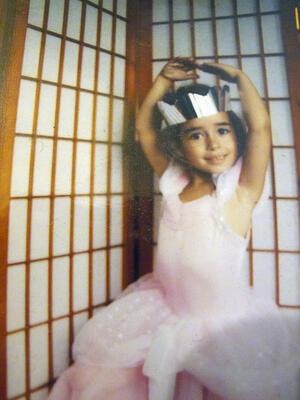More than Meets the Eye
This month our Rising Voices Fellows are examining how their Jewish and feminist identities intersect. Be sure to check the JWA blog each Tuesday for a new post from our fellows—and check out the great educational resources provided by our partner organization, Prozdor.
We all deal with the misconceptions of other people about our passions. For me, those misconceptions repeatedly touch on my identity as a Jewish feminist dancer. Now when I mean feminist, I do not mean the stereotypical kind that burn bras in trash cans, but rather somebody who thinks equal empowerment is morally correct. Being a teenage girl, I believe girls like me should, and have the right to, feel empowered. Which brings me to my passions for dance and Judaism—the two things that have always allowed me to feel strong.
When I started high school and told people that I was Jewish, they seemed surprised—and that surprised me. When I asked them why, it seemed that I did not fit their “typical” Jewish girl profile, an image that was pretty vague to begin with. Most connected Jews with images of suburban “JAPs” (Jewish American Princesses) or the ultra-Orthodox Hasids you sometimes see on the news.
It bothers me that some see Judaism as more of a religion affiliated with stereotypes, when to me Judaism is a spiritual bond that connects communities from around the globe.
I recently had the pleasure to listen to Jewish-Filipino Geraldine Acuna-Sunshine recount her hands-on experience helping tsunami victims from her home island in the Philippines. I was struck as she recounted in emotional detail the Jewish community’s outreach to victims of the tsunami. You would think the affairs of a country like the Philippines would not reach Jews on a religious level, yet the Joint Distribution Committee and the Israeli Defense Forces immediately set out to aid communities affected by the tsunami, driven by the Jewish act of hesed, or compassionate outreach. This international bond of hesed helped the needy Jewish communities in the Philippines and proved that being a Jew means compassion for others.
This significant unity I feel with my fellow Jews who I know will always reach out to me is mirrored in my bond for my fellow dancers. In our performing arts high school, my dance major classmates and I share an understanding of the strength required to be a true dancer. And, just like the many misconceptions I’ve encountered in regards to my Jewish identity, I’ve found many people still have conventional misconceptions about dancers, ballerinas in particular. Dancers are not simply ultra-feminine princesses who smile while prancing up and down a stage; they are more than that—they embody true female power.
Back in the early 20th century, women’s abilities to contribute to society were barely ever showcased. While everyday society deprived women of social and political rights, dance allowed them to grow as individuals and artists, with a woman’s technical capabilities exhibited in each dance performance. But what’s more, ballet also granted women unique physical strength. Most only notice the dazzling tutu in a promo picture for a local ballet company, but if you take a second look at the ballerina’s physique, you should notice how incredibly defined her muscles are. Ballerinas carry the strength to execute the painstakingly impossible—literally on the tips of their toes—with controlled ease. Ballerinas are not just willowy, fragile girls; they symbolize the strength and talent that has shone through the degrading barriers against women.
At the end of the day, it is okay that some may not completely understand my values, religion, or passions. As long as I have the heart and the knowledge to stick to my beliefs, I will know how to respond to those who confront me with any misconceptions about my identity—because when it comes to who I am there is a lot more strength to me than what may meet the eye.
This piece was written as part of JWA’s Rising Voices Fellowship.







Just to clarify - this image you invoke of feminists who "burn bras in trash cans" - feminists have never actually burned bras. At the event you're referring to, the protest of the 1971 Miss America Pageant, there was a Freedom Trash Can where feminists threw out objects of traditional femininity, like bras, but they were never burned.
Otherwise, great piece!
Very nice piece - thanks for sharing I am afraid that there are misconceptions and stereotypes all over in all fields. One important thing is to realize that we live in a country that allows your to express yourself freely without the fear of dire consequences. Keep up the good work
interesting history of women in dance! go Jewish athletes http://forward.com/articles/19...
Great post Olivia}